安徽省六安第一中学2015-2016学年高一下学期开学考试英语试题 Word版含答案.doc
- 格式:doc
- 大小:127.50 KB
- 文档页数:12

2015~2016学年度高一下学期英语试题★沉着冷静规范答题端正考风严禁舞弊★第Ⅰ卷第一部分听力(1—20小题)英语听力共两节,共20小题,每小题1.5分,满分30分。
第一节(共5小题;每小题1. 5分, 满分7. 5分)听下面5段对话。
每段对话后有一个小题, 从题中所给的A、B、C三个选项中选出最佳选项, 并标在试卷的相应位置。
1.What are the two speakers doing?A.Singing a song.B. Riding a bike.C. Dancing.2.What can we know about the meat?A.Its price has risen.B.It is cheaper in other shops.C.It is as expensive as fish.3.How will they cross the river?A.By ferry.B. By car.C. By plane.4.How many classes does the woman NOT like?A.Five.B. Ten.C. Nine5.How old is Jane now?A.27B. 22C. 29第二节(共15小题:每小题1.5分,满分22.5分)听下面5段对话。
每段对话后有几个小题,从题中所给的A、B、C三个选项中选出最佳选项,并标在试卷的相应位置。
听第6段材料,回答第6至8题。
6.How long was the woman late?A.For an hour.B. For half an hour.C. For an hour and a half.7.How will the woman go to the restaurant?A.By bus.B. By taxi.C. On foot.8.What will the woman find near the restaurant?A. A drugstore.B. A supermarket.C. A coffee shop.听第7段材料,回答第9至11题。
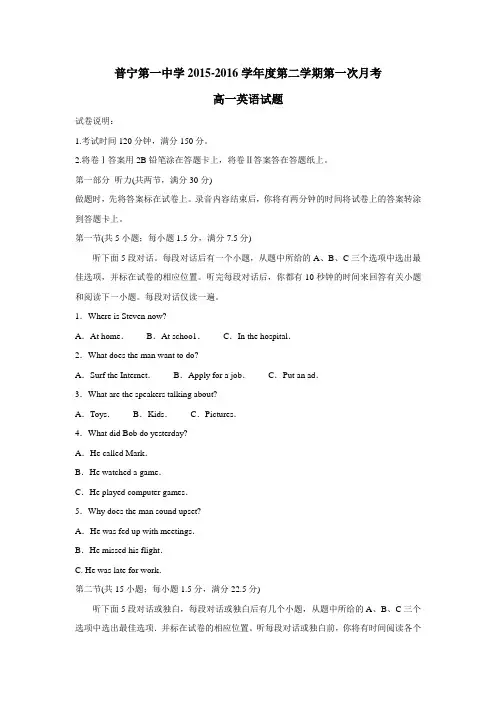
普宁第一中学2015-2016学年度第二学期第一次月考高一英语试题试卷说明:1.考试时间120分钟,满分150分。
2.将卷Ⅰ答案用2B铅笔涂在答题卡上,将卷Ⅱ答案答在答题纸上。
第一部分听力(共两节,满分30分)做题时,先将答案标在试卷上。
录音内容结束后,你将有两分钟的时间将试卷上的答案转涂到答题卡上。
第一节(共5小题;每小题1.5分,满分7.5分)听下面5段对话。
每段对话后有一个小题,从题中所给的A、B、C三个选项中选出最佳选项,并标在试卷的相应位置。
听完每段对话后,你都有10秒钟的时间来回答有关小题和阅读下一小题。
每段对话仅读一遍。
1.Where is Steven now?A.At home.B.At schoo1.C.In the hospital.2.What does the man want to do?A.Surf the Internet.B.Apply for a job.C.Put an ad.3.What are the speakers talking about?A.Toys.B.Kids.C.Pictures.4.What did Bob do yesterday?A.He called Mark.B.He watched a game.C.He played computer games.5.Why does the man sound upset?A.He was fed up with meetings.B.He missed his flight.C. He was late for work.第二节(共15小题;每小题1.5分,满分22.5分)听下面5段对话或独白,每段对话或独白后有几个小题,从题中所给的A、B、C三个选项中选出最佳选项.并标在试卷的相应位置。
听每段对话或独白前,你将有时间阅读各个小题,每小题5秒钟;听完后,各小题将给出5秒钟的作答时间。
每段对话或独白读两遍。
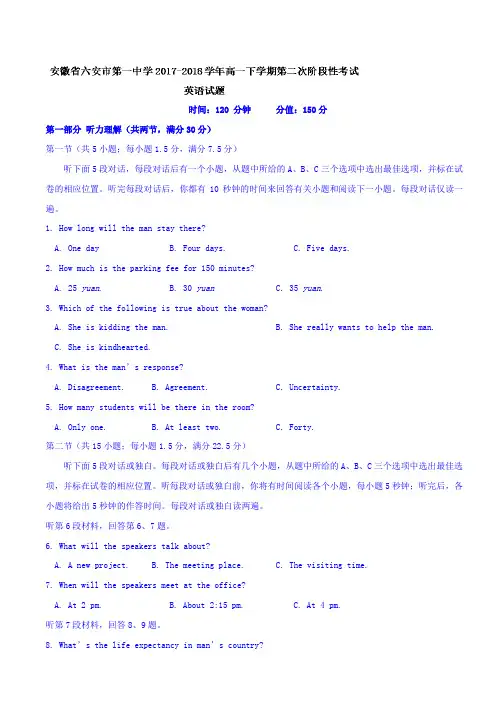
时间:120 分钟分值:150分第一部分听力理解(共两节,满分30分)第一节(共5小题;每小题1.5分,满分7.5分)听下面5段对话,每段对话后有一个小题,从题中所给的A、B、C三个选项中选出最佳选项,并标在试卷的相应位置。
听完每段对话后,你都有10秒钟的时间来回答有关小题和阅读下一小题。
每段对话仅读一遍。
1. How long will the man stay there?A. One dayB. Four days.C. Five days.2. How much is the parking fee for 150 minutes?A. 25 yuan.B. 30 yuanC. 35 yuan.3. Which of the following is true about the woman?A. She is kidding the man.B. She really wants to help the man.C. She is kindhearted.4. What is the man’s response?A. Disagreement.B. Agreement.C. Uncertainty.5. How many students will be there in the room?A. Only one.B. At least two.C. Forty.第二节(共15小题;每小题1.5分,满分22.5分)听下面5段对话或独白。
每段对话或独白后有几个小题,从题中所给的A、B、C三个选项中选出最佳选项,并标在试卷的相应位置。
听每段对话或独白前,你将有时间阅读各个小题,每小题5秒钟;听完后,各小题将给出5秒钟的作答时间。
每段对话或独白读两遍。
听第6段材料,回答第6、7题。
6. What will the speakers talk about?A. A new project.B. The meeting place.C. The visiting time.7. When will the speakers meet at the office?A. At 2 pm.B. About 2:15 pm.C. At 4 pm.听第7段材料,回答8、9题。
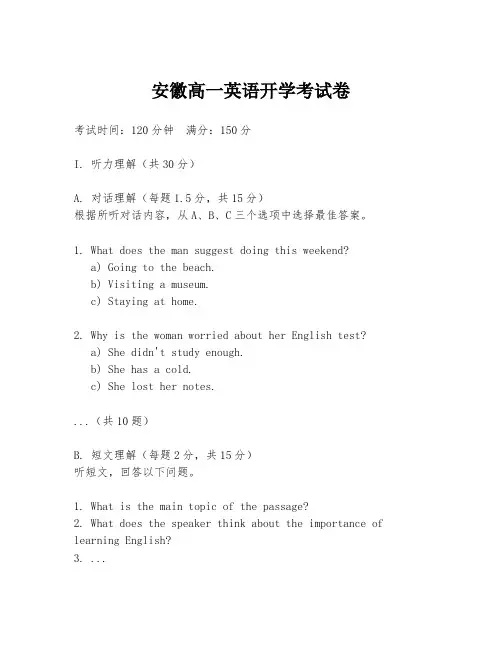
安徽高一英语开学考试卷考试时间:120分钟满分:150分I. 听力理解(共30分)A. 对话理解(每题1.5分,共15分)根据所听对话内容,从A、B、C三个选项中选择最佳答案。
1. What does the man suggest doing this weekend?a) Going to the beach.b) Visiting a museum.c) Staying at home.2. Why is the woman worried about her English test?a) She didn't study enough.b) She has a cold.c) She lost her notes....(共10题)B. 短文理解(每题2分,共15分)听短文,回答以下问题。
1. What is the main topic of the passage?2. What does the speaker think about the importance of learning English?3. ...II. 阅读理解(共40分)A. 阅读理解选择题(每题2分,共20分)阅读下列短文,从A、B、C、D四个选项中选择最佳答案。
Passage 1In recent years, the number of students studying abroad has been increasing...1. What is the main idea of the passage?2. According to the passage, what is the reason for the increase in the number of students studying abroad?3. ...Passage 2The use of technology in education has transformed the way students learn...1. What is the author's view on the use of technology in education?2. What are the benefits mentioned in the passage?3. ...B. 阅读理解简答题(每题4分,共20分)阅读以下短文,根据短文内容回答问题。
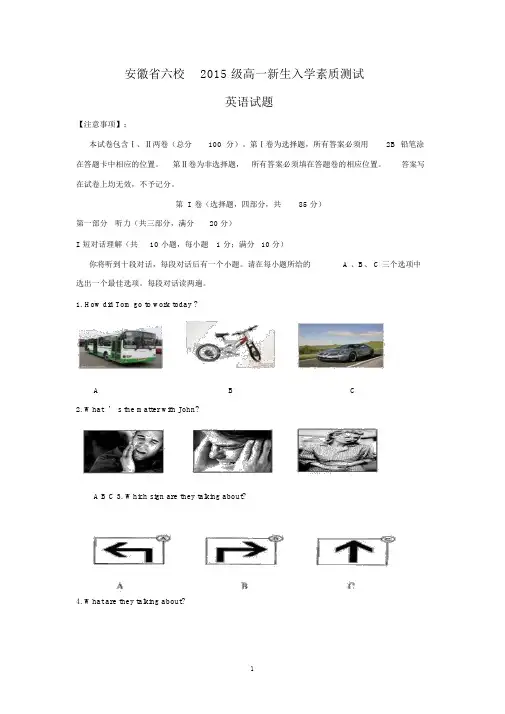
安徽省六校2015 级高一新生入学素质测试英语试题【注意事项】:本试卷包含Ⅰ、Ⅱ两卷(总分100 分)。
第Ⅰ卷为选择题,所有答案必须用2B 铅笔涂在答题卡中相应的位置。
第Ⅱ卷为非选择题,所有答案必须填在答题卷的相应位置。
答案写在试卷上均无效,不予记分。
第 I 卷(选择题,四部分,共85 分)第一部分听力(共三部分,满分20 分)I. 短对话理解(共10 小题,每小题 1 分;满分10 分)你将听到十段对话,每段对话后有一个小题。
请在每小题所给的 A 、B、 C 三个选项中选出一个最佳选项。
每段对话读两遍。
1. How did Tom go to work today ?A B C2. What ’ s the matter with John?A B C 3. Which sign are they talking about?4. What are they talking about?5. What will the weather be like tomorrow?6. Where are the two speakers?A. In the bankB. In the hospitalC. In the police station7. How much will the man pay for four shirts?A.$4B. $7C. $148. What did the woman do yesterday?A. She went to schoolB. She called on SmithC. She went to a hospital9. How long has the woman kept the camera?A. Three yearsB. Six yearsC. Eight years10. How far is it from the woman's home to school?A. 60 milesB. 16 milesC. 6 milesII.长对话理解(共 5 小题,每小题 1 分;满分 5 分)你将听到两段对话,每段对话后有几个小题。
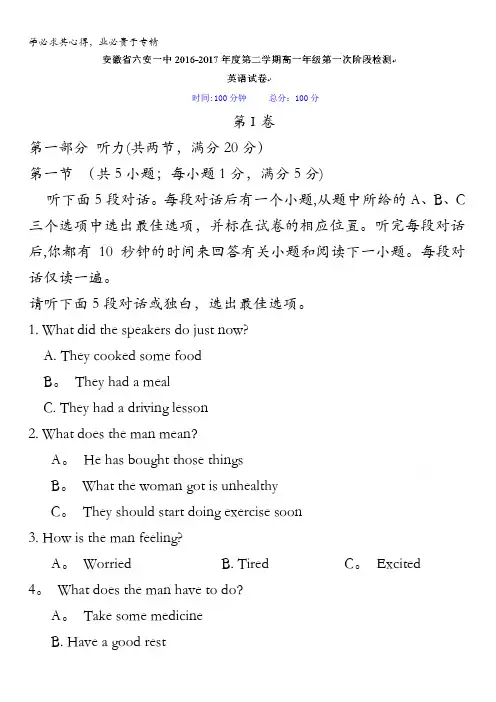
时间:100分钟总分:100分第I卷第一部分听力(共两节,满分20分)第一节(共5小题;每小题1分,满分5分)听下面5段对话。
每段对话后有一个小题,从题中所给的A、B、C 三个选项中选出最佳选项,并标在试卷的相应位置。
听完每段对话后,你都有10秒钟的时间来回答有关小题和阅读下一小题。
每段对话仅读一遍。
请听下面5段对话或独白,选出最佳选项。
1. What did the speakers do just now?A. They cooked some foodB。
They had a mealC. They had a driving lesson2. What does the man mean?A。
He has bought those thingsB。
What the woman got is unhealthyC。
They should start doing exercise soon3. How is the man feeling?A。
Worried B. Tired C。
Excited4。
What does the man have to do?A。
Take some medicineB. Have a good restC. Change his opinions about life5。
About whom is the woman worried?A. Her children B。
Her parents C. Her husband第二节(共15小题;每小题1分,满分15分)听下面5段对.每段对话后有几个小题,从题中所给的A、B、C 三个选项中选出最佳选项,并标在试卷的相应位置.听每段对话后,你都有10秒钟的时间来回答有关小题和阅读下一小题。
每段对话仅读一遍。
请听第6段材料,回答第6、7题。
6。
When did the woman have dinner with Jack?A。
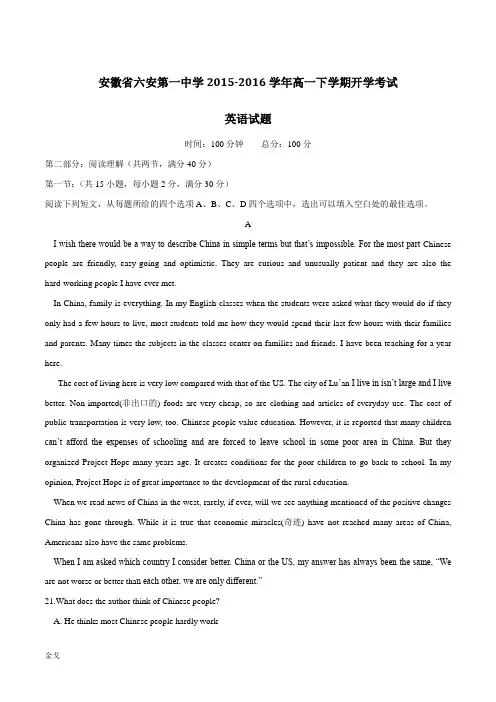
安徽省六安第一中学2015-2016学年高一下学期开学考试英语试题时间:100分钟总分:100分第二部分:阅读理解(共两节,满分40分)第一节:(共15小题,每小题2分,满分30分)阅读下列短文,从每题所给的四个选项A、B、C、D四个选项中,选出可以填入空白处的最佳选项。
AI wish there would be a way to describe China in simple terms but that’s impossible. For the most part Chinese people are friendly, easy-going and optimistic. They are curious and unusually patient and they are also the hard-working people I have ever met.In China, family is everything. In my English classes when the students were asked what they would do if they only had a few hours to live, most students told me how they would spend their last few hours with their families and parents. Many times the subjects in the classes center on families and friends. I have been teaching for a year here.The cost of living here is very low compared with that of the US. The city of Lu’an I live in isn’t large and I live better. Non-imported(非出口的) foods are very cheap, so are clothing and articles of everyday use. The cost of public transportation is very low, too. Chinese people value education. However, it is reported that many children can’t afford the expenses of schooling and are forced to leave school in some poor area in China. But they organized Project Hope many years age. It creates conditions for the poor children to go back to school. In my opinion, Project Hope is of great importance to the development of the rural education.When we read news of China in the west, rarely, if ever, will we see anything mentioned of the positive changes China has gone through. While it is true that economic miracles(奇迹) have not reached many areas of China, Americans also have the same problems.When I am asked which country I consider better. China or the US, my answer has always been the same, “We are not worse or better tha n each other, we are only different.”21.What does the author think of Chinese people?A. He thinks most Chinese people hardly workB. He thinks most Chinese people are proudC. He praises most Chinese people a lotD. He dislikes most Chinese people22.What is the author doing in China?A. He is on his summer vacation.B. He is teaching English in a schoolC. He is studying in a collegeD. He is on business23.What are not cheap in China in the author’s opinion?A. Clothes and shoes made in ChinaB. Local foodsC. Public transportation ticketsD. Imported foods24.We can infer from the passage that the author thinks______.A. the westerners have got to know China wellB. China’s economic miracles have appeared everywhereC. the progress of China is seldom reported in the USD. the education in rural areas is never cared about in USBNow we answer a question from Bangladesh(孟加拉国). Out listener wants to know about the history of the number 13 and why Americans consider this number to be bad luck.It is not only Americans who consider this number to be unlucky. People around the world have what are called superstitions(迷信) about the number 13. Superstitions are popular beliefs that are not based on reason or science. A person believes something brings good or bad luck.This fear is so strong around the world that many tall buildings do not have a 13th level. And, many airports do not have a gate numbered 13. Even some cities and town skip over 13th Street. The number 13 is not an object or a situation, and it can be impossible for the sufferer to avoid.Some experts say fears about this number come from ancient religious stories. One Norse myth(神话) is about twelve gods who were having a party in their heaven, Valhalla. Loki, the god of evil and disorder, arrived at thedinner party uninvited. He became the 13th person at the table. Loki then helped cause the death of Balder, the god of joy.In the Christian book, the Bible, Judas is the 13th guest at the dinner called the Last Supper. Judas is the man who betrays(背叛) Jesus, leading to his death.Many people around the world also consider Fridays that fall on the 13th day of a month to be especially bad luck.Many cultures have traditions of unlucky numbers other than 13. These beliefs, like our fear of 13, are mostly rooted in ancient events that were somehow connected with the number in question. The fear of numbers is a very fear for many people. It appears to be an ancient and widespread fear whose origins may never be fully understand.25. The underlined phrase “skip over” in Paragraph 3 means_______.A. includeB. cancelC. divideD. prefer26. What’s the main idea of the third paragraph?A. Why the number 13 is rarely seen in public places.B. The fear of the number 13 must be dealt with seriously.C. The fear of the number 13 common in the world.D. The number 13 causes much trouble in people’s lives.27. According to the Norse myth, the number 13 is unlucky because the 13th guest_______.A. killed the god of joy at the dinner tableB. brought bad luck to the others at the partyC. helped cause the death of Jesus at supper.D. helped cause the death of Balder28. The passage is probably taken from______A. a history bookB. a radio programC. a science magazineD. a travel guideCFor the most part, you are probably only exposed to the music that is played on your favorite radio stations, TV shows, music websites, or the music that your friends and family members enjoy. While you probably know a lot about your favorite type of music, it can be a rewarding experience to enlarge your horizons (眼界)if you are trying to discover artists and types of music that you're not familiar with. You might discover you like certain types ofmusic you never even considered.Have you ever wondered about the history and influences of your favorite types of music ? For example, did you know that rock 'n' roll originated (起源) from the blues, and that the blues began as a form of musical expression for African Americans during slavery (奴隶制度)? Did you know that most hip-hop is heavily influenced by early rhythm blues and jazz ?There are many fun ways to learn about different musical styles and their historical roots. For example, if you like hip-hop, listen to some of your favorite CDs and take note of the samples the performers used to create the songs. There is a possibility that the artist used parts of older songs to create the music. You can go to the library or online to learn more about the artists and listen to more of their music by checking out CDs from the library or downloading songs online for a small fee.You can learn so much about culture and history just by paying attention to different types of music and what is being expressed in the songs. There are so many different styles of music to learn about, and you owe it to yourself to make an effort to listen to and learn about them.29. The main topic of this passage is _____.A. creating musicB. learning about musicC. enjoying your favorite musicD. performing music30. What music did African Americans use to express their feelings of being slaves ?A. Rock 'n' roll.B. Hip-hop.C. The blues.D. Jazz.31. How can we learn about culture and history through music ?A. By caring about what is being expressed in music.B. By creating music from older songs ourselves.C. By writing down the names of the music.D. By keeping a record of fees after downloading songs online.32. What does the underlined sentence in the last paragraph mean?A. you should return something to musicB. you should try harder to learn about musicC. you should borrow music CDs from othersD. you should buy music CDs yourselfDThe National GalleryDescription:The National Gallery is the British national art museum built on the north side of Trafalgar Square in London. It houses a diverse collection of more than 2,300 examples of European art ranging from 13th-century religious paintings to more modern ones by Renoir and Van Gogh. The older collections of the gallery are reached through the main entrance while the more modern works in the East Wing are most easily reached from Trafalgar Square by a ground floor entranceLayout:The modern Sainsbury Wing on the western side of the building houses 13thto 15thcentury paintings, and artists include Duccio, Uccello, Van Eyck, Lippi, Mantegna,Botticelli and Memling.The main West Wing houses 16thcentury paintings,and artists include Leonardo da Vinci, Cranach,Michelangelo, Raphael, Bruegel,, Bronzino, Titian and V eronese.The North Wing houses 17thcentury paintings, and artists include Caravaggio, Rubens, Poussin, Van Dyck, Velazquez, Claude and Vermeer.The East Wing houses 18thto early 20thcentury paintings, and artists include Canaletto, Goya, Turner, Constable,Renoir and Van Gogh.Opening Hours:The Gallery is open every day from 10am to 6pm (Fridays 10am to 9pm) and is free,but charges apply to some special exhibitions.Getting There:Nearest underground stations:Charing Cross (2minute walk), Leicester Square (3minute walk), Embankment (7minute walk), and Piccadilly Circus (8minute walk).33. In which century’s collection can you see religious paintings?A. The 13thB. The 17thC. The 18thD. The 20th34. Where are Leonardo da Vinci’s works shown?A. In the East Wing.B. In the main West Wing.C. In the Sainsbury Wing.D. In the North Wing.35. Which underground station is closest to the National Gallery?A. Piccadilly Circus.B. Leicester Square.C. Embankment.D. Charing Cross.第二节(共5小题,每小题2分,满分10分)根据短文内容,从短文后的选项中选出能填入空白处的最佳选项。
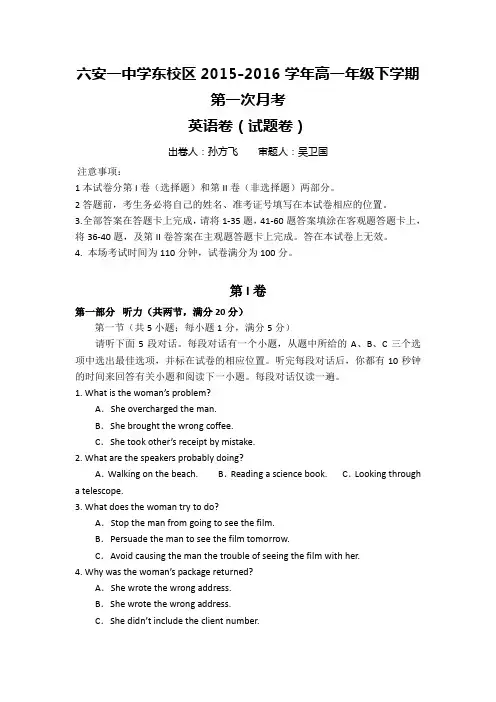
六安一中学东校区2015-2016学年高一年级下学期第一次月考英语卷(试题卷)出卷人:孙方飞审题人:吴卫国注意事项:1本试卷分第I卷(选择题)和第II卷(非选择题)两部分。
2答题前,考生务必将自己的姓名、准考证号填写在本试卷相应的位置。
3.全部答案在答题卡上完成,请将1-35题,41-60题答案填涂在客观题答题卡上,将36-40题,及第II卷答案在主观题答题卡上完成。
答在本试卷上无效。
4. 本场考试时间为110分钟,试卷满分为100分。
第I卷第一部分听力(共两节,满分20分)第一节(共5小题;每小题1分,满分5分)请听下面5段对话。
每段对话有一个小题,从题中所给的A、B、C三个选项中选出最佳选项,并标在试卷的相应位置。
听完每段对话后,你都有10秒钟的时间来回答有关小题和阅读下一小题。
每段对话仅读一遍。
1. What is the woman’s problem?A.She overcharged the man.B.She brought the wrong coffee.C.She took other’s receipt by mistake.2. What are the speakers probably doing?A.Walking on the beach. B.Reading a science book. C.Looking througha telescope.3. What does the woman try to do?A.Stop the man from going to see the film.B.Persuade the man to see the film tomorrow.C.Avoid causing the man the trouble of seeing the film with her.4. Why was the woman’s package returned?A.She wrote the wrong address.B.She wrote the wrong address.C.She didn’t include the client num ber.5. What are the speakers mainly talking about?A.A theft. B.A policy . C.A department.第二节(共15小题;每小题1分,满分22分)请听下面5段对话或独白。
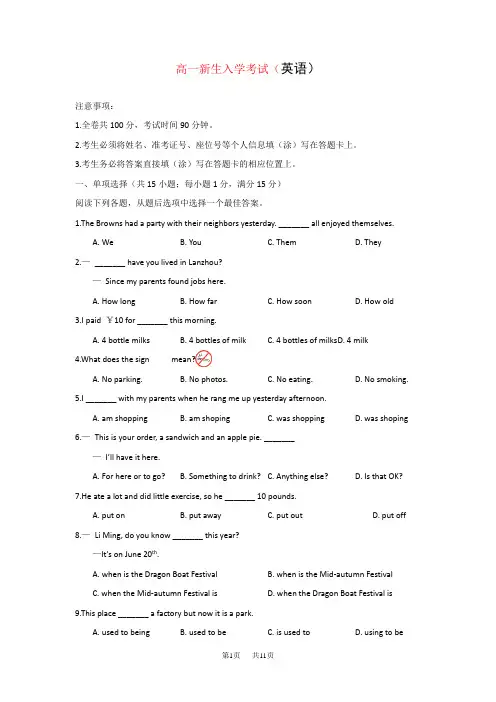
高一新生入学考试(英语)注意事项:1.全卷共100分,考试时间90分钟。
2.考生必须将姓名、准考证号、座位号等个人信息填(涂)写在答题卡上。
3.考生务必将答案直接填(涂)写在答题卡的相应位置上。
一、单项选择(共15小题;每小题1分,满分15分)阅读下列各题,从题后选项中选择一个最佳答案。
1.The Browns had a party with their neighbors yesterday. _______ all enjoyed themselves.A. WeB. YouC. ThemD. They2.—_______ have you lived in Lanzhou?—Since my parents found jobs here.A. How longB. How farC. How soonD. How old3.I paid ¥10 for _______ this morning.A. 4 bottle milksB. 4 bottles of milkC. 4 bottles of milksD. 4 milk4.What does the sign mean?A. No parking.B. No photos.C. No eating.D. No smoking.5.I _______ with my parents when he rang me up yesterday afternoon.A. am shoppingB. am shopingC. was shoppingD. was shoping6.—This is your order, a sandwich and an apple pie. _______—I’ll have it here.A. For here or to go?B. Something to drink?C. Anything else?D. Is that OK?7.He ate a lot and did little exercise, so he _______ 10 pounds.A. put onB. put awayC. put outD. put off8.—Li Ming, do you know _______ this year?—It’s on June 20th.A. when is the Dragon Boat FestivalB. when is the Mid-autumn FestivalC. when the Mid-autumn Festival isD. when the Dragon Boat Festival is9.This place _______ a factory but now it is a park.A. used to beingB. used to beC. is used toD. using to be10.—I wonder if this smart phone is Mary’s.—It _______ belong to her. _______ is totally different from this one.A. mustn’t; HerB. can’t; HerC. can’t; HersD. may; Hers11.He has ordered a watch on line for his father and it _______ to him before Father’s Day.A. sendB. will be sentC. was sentD. sent12._______ of the land in that district is covered with trees and grass.A. Fifth twoB. Two fifthC. Fifth secondD. Two fifths13.—How do you like this house?—_______ It’s everything I’ve been looking for.A. Terrible!B. Perfect!C. Awful!D. Delicious!14.She says that she’ll have to close the shop _______ business improves.A. ifB. orC. unlessD. because15.Which sound goes with the word “fiction”?二、完形填空(共15小题;每小题1分,满分15分)阅读下面的短文,从短文后各题所给的选项中选出能填入空白处的最佳答案。
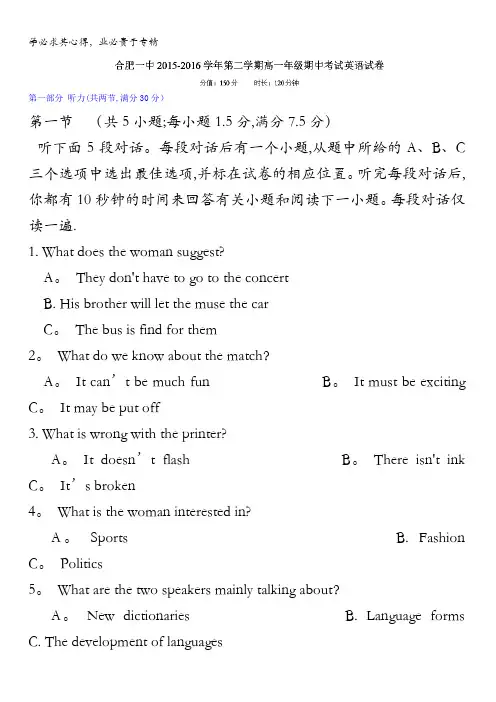
第一部分听力(共两节,满分30分)第一节(共5小题;每小题1.5分,满分7.5分)听下面5段对话。
每段对话后有一个小题,从题中所给的A、B、C 三个选项中选出最佳选项,并标在试卷的相应位置。
听完每段对话后,你都有10秒钟的时间来回答有关小题和阅读下一小题。
每段对话仅读一遍.1. What does the woman suggest?A。
They don't have to go to the concertB. His brother will let the muse the carC。
The bus is find for them2。
What do we know about the match?A。
It can’t be much fun B。
It must be exciting C。
It may be put off3. What is wrong with the printer?A。
It doesn’t flash B。
There isn't ink C。
It’s broken4。
What is the woman interested in?A。
Sports B. Fashion C。
Politics5。
What are the two speakers mainly talking about?A。
New dictionaries B. Language forms C. The development of languages第二节(共15小题)听下面5段对话或独白.每段对话或独白后有几个小题,从题中所给的A、B、C三个选项中选出最佳选项,并标在试卷的相应位置。
听每段对话或独白前,你将有时间阅读各个小题,每小题5秒钟;听完后,各小题将给出5秒钟的作答时间。
每段对话或独白读两遍。
听第6段材料,回答第6至7题.6。
What's wrong with the man?A。
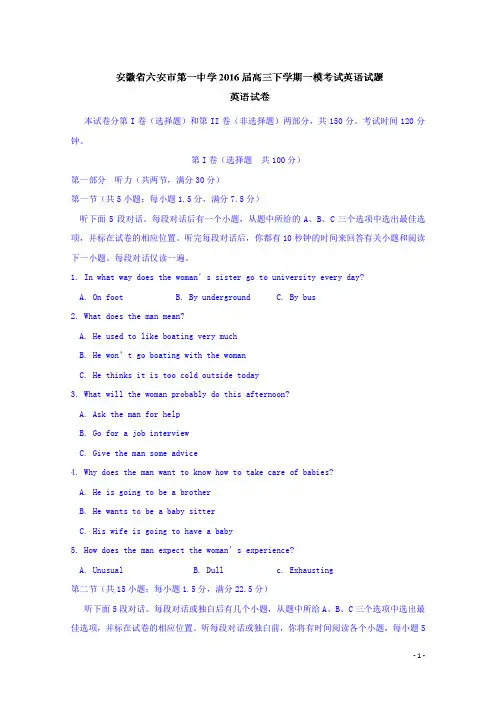
本试卷分第I卷(选择题)和第II卷(非选择题)两部分,共150分。
考试时间120分钟。
第I卷(选择题共100分)第一部分听力(共两节,满分30分)第一节(共5小题;每小题1.5分,满分7.5分)听下面5段对话。
每段对话后有一个小题,从题中所给的A、B、C三个选项中选出最佳选项,并标在试卷的相应位置。
听完每段对话后,你都有10秒钟的时间来回答有关小题和阅读下一小题。
每段对话仅读一遍。
1. In what way does the woman’s sister go to university every day?A. On footB. By undergroundC. By bus2. What does the man mean?A. He used to like boating very muchB. He won’t go boating with the womanC. He thinks it is too cold outside today3. What will the woman probably do this afternoon?A. Ask the man for helpB. Go for a job interviewC. Give the man some advice4. Why does the man want to know how to take care of babies?A. He is going to be a brotherB. He wants to be a baby sitterC. His wife is going to have a baby5. How does the man expect the woman’s experience?A. UnusualB. Dull c. Exhausting第二节(共15小题;每小题1.5分,满分22.5分)听下面5段对话。
六安一中东校区2014~2015学年第二学期高一年级开学考试英语试卷命题人:何正瓛时间:100分钟满分:100分第I卷(选择题共80分)第一部分:听力(共两节,满分20分)第一节(共5小题;每小题1分,满分5分)听下面5段对话。
每段对话后有一个小题,从题中所给的A、B、C三个选项中选出最佳选项,并标在试卷的相应位置。
听完每段对话后,你都有10秒钟的时间来回答有关小题和阅读下一小题。
每段对话仅读一遍。
1.What did Jack finish at about 8:30?A. His exercises.B.A letter.C.A story.2.Why will the woman stay at home in the evening?A. To wait for a call.B. To watch a ball game on TV.C .To have dinner with a friend.3.What are the two speakers doing?A. Learning driving.B. Practising typing.C. Surfing the Internet.4.Who likes blue coats?A. The girl.B. The girl’s mother.C. John.5.What do you think the man will do at last?A. Help the woman push her car.B. Let the woman push her own car.C. Ask someone to push the car for the woman.第二节(共15小题;每小题1分,满分15分)听下面5段对话或独白。
每段对话或独白后有几个小题,从题中所给的A、B、C三个选项中选出最佳选项,并标在试卷的相应位置。
听每段对话或独白前,你将有时间阅读各个小题,每小题5秒钟;听完后,各小题将给出5秒钟的作答时间。
安徽省六安第一中学2015-2016学年高一下学期开学考试英语试题时间:100分钟总分:100分第二部分:阅读理解(共两节,满分40分)第一节:(共15小题,每小题2分,满分30分)阅读下列短文,从每题所给的四个选项A、B、C、D四个选项中,选出可以填入空白处的最佳选项。
AI wish there would be a way to describe China in simple terms but that’s impossible. For the most part Chinese people are friendly, easy-going and optimistic. They are curious and unusually patient and they are also the hard-working people I have ever met.In China, family is everything. In my English classes when the students were asked what they would do if they only had a few hours to live, most students told me how they would spend their last few hours with their families and parents. Many times the subjects in the classes center on families and friends. I have been teaching for a year here.The cost of living here is very low compared with that of the US. The city of Lu’an I live in isn’t large and I live better. Non-imported(非出口的) foods are very cheap, so are clothing and articles of everyday use. The cost of public transportation is very low, too. Chinese people value education. However, it is reported that many children can’t afford the expenses of schooling and are forced to leave school in some poor area in China. But they organized Project Hope many years age. It creates conditions for the poor children to go back to school. In my opinion, Project Hope is of great importance to the development of the rural education.When we read news of China in the west, rarely, if ever, will we see anything mentioned of the positive changes China has gone through. While it is true that economic miracles(奇迹) have not reached many areas of China, Americans also have the same problems.When I am asked which country I consider better. China or the US, my answer has always been the same, “We are not worse or better than each other, we are only different.”21.What does the author think of Chinese people?A. He thinks most Chinese people hardly workB. He thinks most Chinese people are proudC. He praises most Chinese people a lotD. He dislikes most Chinese people22.What is the author doing in China?A. He is on his summer vacation.B. He is teaching English in a schoolC. He is studying in a collegeD. He is on business23.What are not cheap in China in the author’s opinion?A. Clothes and shoes made in ChinaB. Local foodsC. Public transportation ticketsD. Imported foods24.We can infer from the passage that the author thinks______.A. the westerners have got to know China wellB. China’s economic miracles have appeared everywhereC. the progress of China is seldom reported in the USD. the education in rural areas is never cared about in USBNow we answer a question from Bangladesh(孟加拉国). Out listener wants to know about the history of the number 13 and why Americans consider this number to be bad luck.It is not only Americans who consider this number to be unlucky. People around the world have what are called superstitions(迷信) about the number 13. Superstitions are popular beliefs that are not based on reason or science. A person believes something brings good or bad luck.This fear is so strong around the world that many tall buildings do not have a 13th level. And, many airports do not have a gate numbered 13. Even some cities and town skip over 13th Street. The number 13 is not an object or a situation, and it can be impossible for the sufferer to avoid.Some experts say fears about this number come from ancient religious stories. One Norse myth(神话) is about twelve gods who were having a party in their heaven, Valhalla. Loki, the godof evil and disorder, arrived at the dinner party uninvited. He became the 13th person at the table. Loki then helped cause the death of Balder, the god of joy.In the Christian book, the Bible, Judas is the 13th guest at the dinner called the Last Supper. Judas is the man who betrays(背叛) Jesus, leading to his death.Many people around the world also consider Fridays that fall on the 13th day of a month to be especially bad luck.Many cultures have traditions of unlucky numbers other than 13. These beliefs, like our fear of 13, are mostly rooted in ancient events that were somehow connected with the number in question. The fear of numbers is a very fear for many people. It appears to be an ancient and widespread fear whose origins may never be fully understand.25. The underlined phrase “skip over” in Paragraph 3 means_______.A. includeB. cancelC. divideD. prefer26. What’s the main idea of the third paragraph?A. Why the number 13 is rarely seen in public places.B. The fear of the number 13 must be dealt with seriously.C. The fear of the number 13 common in the world.D. The number 13 causes much trouble in people’s lives.27. According to the Norse myth, the number 13 is unlucky because the 13th guest_______.A. killed the god of joy at the dinner tableB. brought bad luck to the others at the partyC. helped cause the death of Jesus at supper.D. helped cause the death of Balder28. The passage is probably taken from______A. a history bookB. a radio programC. a science magazineD. a travel guideCFor the most part, you are probably only exposed to the music that is played on your favorite radio stations, TV shows, music websites, or the music that your friends and family members enjoy. While you probably know a lot about your favorite type of music, it can be a rewarding experience to enlarge your horizons (眼界)if you are trying to discover artists and types of musicthat you're not familiar with. You might discover you like certain types of music you never even considered.Have you ever wondered about the history and influences of your favorite types of music ? For example, did you know that rock 'n' roll originated (起源) from the blues, and that the blues began as a form of musical expression for African Americans during slavery (奴隶制度)? Did you know that most hip-hop is heavily influenced by early rhythm blues and jazz ?There are many fun ways to learn about different musical styles and their historical roots. For example, if you like hip-hop, listen to some of your favorite CDs and take note of the samples the performers used to create the songs. There is a possibility that the artist used parts of older songs to create the music. You can go to the library or online to learn more about the artists and listen to more of their music by checking out CDs from the library or downloading songs online for a small fee.You can learn so much about culture and history just by paying attention to different types of music and what is being expressed in the songs. There are so many different styles of music to learn about, and you owe it to yourself to make an effort to listen to and learn about them.29. The main topic of this passage is _____.A. creating musicB. learning about musicC. enjoying your favorite musicD. performing music30. What music did African Americans use to express their feelings of being slaves ?A. Rock 'n' roll.B. Hip-hop.C. The blues.D. Jazz.31. How can we learn about culture and history through music ?A. By caring about what is being expressed in music.B. By creating music from older songs ourselves.C. By writing down the names of the music.D. By keeping a record of fees after downloading songs online.32. What does the underlined sentence in the last paragraph mean?A. you should return something to musicB. you should try harder to learn about musicC. you should borrow music CDs from othersD. you should buy music CDs yourselfDThe National GalleryDescription:The National Gallery is the British national art museum built on the north side of Trafalgar Square in London. It houses a diverse collection of more than 2,300 examples of European art ranging from 13th-century religious paintings to more modern ones by Renoir and V an Gogh. The older collections of the gallery are reached through the main entrance while the more modern works in the East Wing are most easily reached from Trafalgar Square by a ground floor entrance Layout:The modern Sainsbury Wing on the western side of the building houses 13thto 15thcentury paintings, and artists include Duccio, Uccello, Van Eyck, Lippi, Mantegna,Botticelli and Memling.The main West Wing houses 16thcentury paintings,and artists include Leonardo da Vinci, Cranach,Michelangelo, Raphael, Bruegel,, Bronzino, Titian and Veronese.The North Wing houses 17thcentury paintings, and artists include Caravaggio, Rubens, Poussin, Van Dyck, Velazquez, Claude and Vermeer.The East Wing houses 18thto early 20thcentury paintings, and artists include Canaletto, Goya, Turner, Constable,Renoir and Van Gogh.Opening Hours:The Gallery is open every day from 10am to 6pm (Fridays 10am to 9pm) and is free,but charges apply to some special exhibitions.Getting There:Nearest underground stations:Charing Cross (2minute walk), Leicester Square (3minute walk), Embankment (7minute walk), and Piccadilly Circus (8minute walk).33. In which century’s collection can you see religious paintings?A. The 13thB. The 17thC. The 18thD. The 20th34. Where are Leonardo da Vinci’s works shown?A. In the East Wing.B. In the main West Wing.C. In the Sainsbury Wing.D. In the North Wing.35. Which underground station is closest to the National Gallery?A. Piccadilly Circus.B. Leicester Square.C. Embankment.D. Charing Cross.第二节(共5小题,每小题2分,满分10分)根据短文内容,从短文后的选项中选出能填入空白处的最佳选项。
安徽省六安第一中学2015—2016学年高一下学期开学考试英语试题时间:100分钟总分:100分第二部分:阅读理解(共两节,满分40分)第一节:(共15小题,每小题2分,满分30分)阅读下列短文,从每题所给的四个选项A、B、C、D四个选项中,选出可以填入空白处的最佳选项。
AI wish there would be a way to describe China in simple terms but that's impossible. For the most part Chinese people are friendly,easy-going and optimistic. They are curious and unusually patient and they are also the hard-working people I have ever met.In China,family is everything. In my English classes when the students were asked what they would do if they only had a few hours to live,most students told me how they would spend their last few hours with their families and parents。
Many times the subjects in the classes center on families and friends. I have been teaching for a year here。
The cost of living here is very low compared with that of the US。
The city of Lu’an I live in isn’t large and I live better。
安徽省六安第一中学2015-2016学年高一下学期开学考试英语试题时间:100分钟总分:100分第二部分:阅读理解(共两节,满分40分)第一节:(共15小题,每小题2分,满分30分)阅读下列短文,从每题所给的四个选项A、B、C、D四个选项中,选出可以填入空白处的最佳选项。
AI wish there would be a way to describe China in simple terms but that’s impossible. For the most part Chinese people are friendly, easy-going and optimistic. They are curious and unusually patient and they are also the hard-working people I have ever met.In China, family is everything. In my English classes when the students were asked what they would do if they only had a few hours to live, most students told me how they would spend their last few hours with their families and parents. Many times the subjects in the classes center on families and friends. I have been teaching for a year here.The cost of living here is very low compared with that of the US. The city of Lu’an I live in isn’t large and I live better. Non-imported(非出口的) foods are very cheap, so are clothing and articles of everyday use. The cost of public transportation is very low, too. Chinese people value education. However, it is reported that many children can’t afford the expenses of schooling and are forced to leave school in some poor area in China. But they organized Project Hope many years age. It creates conditions for the poor children to go back to school. In my opinion, Project Hope is of great importance to the development of the rural education.When we read news of China in the west, rarely, if ever, will we see anything mentioned of the positive changes China has gone through. While it is true that economic miracles(奇迹) have not reached many areas of China, Americans also have the same problems.When I am asked which country I consider better. China or the US, my answer has always been the same, “We are not worse or better than each other, we are only different.”21.What does the author think of Chinese people?A. He thinks most Chinese people hardly workB. He thinks most Chinese people are proudC. He praises most Chinese people a lotD. He dislikes most Chinese people22.What is the author doing in China?A. He is on his summer vacation.B. He is teaching English in a schoolC. He is studying in a collegeD. He is on business23.What are not cheap in China in the author’s opinion?A. Clothes and shoes made in ChinaB. Local foodsC. Public transportation ticketsD. Imported foods24.We can infer from the passage that the author thinks______.A. the westerners have got to know China wellB. China’s economic miracles have appeared everywhereC. the progress of China is seldom reported in the USD. the education in rural areas is never cared about in USBNow we answer a question from Bangladesh(孟加拉国). Out listener wants to know about the history of the number 13 and why Americans consider this number to be bad luck.It is not only Americans who consider this number to be unlucky. People around the world have what are called superstitions(迷信) about the number 13. Superstitions are popular beliefs that are not based on reason or science. A person believes something brings good or bad luck.This fear is so strong around the world that many tall buildings do not have a 13th level. And, many airports do not have a gate numbered 13. Even some cities and town skip over 13th Street. The number 13 is not an object or a situation, and it can be impossible for the sufferer to avoid.Some experts say fears about this number come from ancient religious stories. One Norse myth(神话) is about twelve gods who were having a party in their heaven, Valhalla. Loki, the godof evil and disorder, arrived at the dinner party uninvited. He became the 13th person at the table. Loki then helped cause the death of Balder, the god of joy.In the Christian book, the Bible, Judas is the 13th guest at the dinner called the Last Supper. Judas is the man who betrays(背叛) Jesus, leading to his death.Many people around the world also consider Fridays that fall on the 13th day of a month to be especially bad luck.Many cultures have traditions of unlucky numbers other than 13. These beliefs, like our fear of 13, are mostly rooted in ancient events that were somehow connected with the number in question. The fear of numbers is a very fear for many people. It appears to be an ancient and widespread fear whose origins may never be fully understand.25. The underlined phrase “skip over” in Paragraph 3 means_______.A. includeB. cancelC. divideD. prefer26. What’s the main idea of the third paragraph?A. Why the number 13 is rarely seen in public places.B. The fear of the number 13 must be dealt with seriously.C. The fear of the number 13 common in the world.D. The number 13 causes much trouble in people’s lives.27. According to the Norse myth, the number 13 is unlucky because the 13th guest_______.A. killed the god of joy at the dinner tableB. brought bad luck to the others at the partyC. helped cause the death of Jesus at supper.D. helped cause the death of Balder28. The passage is probably taken from______A. a history bookB. a radio programC. a science magazineD. a travel guideCFor the most part, you are probably only exposed to the music that is played on your favorite radio stations, TV shows, music websites, or the music that your friends and family members enjoy. While you probably know a lot about your favorite type of music, it can be a rewarding experience to enlarge your horizons (眼界)if you are trying to discover artists and types of musicthat you're not familiar with. You might discover you like certain types of music you never even considered.Have you ever wondered about the history and influences of your favorite types of music ? For example, did you know that rock 'n' roll originated (起源) from the blues, and that the blues began as a form of musical expression for African Americans during slavery (奴隶制度)? Did you know that most hip-hop is heavily influenced by early rhythm blues and jazz ?There are many fun ways to learn about different musical styles and their historical roots. For example, if you like hip-hop, listen to some of your favorite CDs and take note of the samples the performers used to create the songs. There is a possibility that the artist used parts of older songs to create the music. You can go to the library or online to learn more about the artists and listen to more of their music by checking out CDs from the library or downloading songs online for a small fee.You can learn so much about culture and history just by paying attention to different types of music and what is being expressed in the songs. There are so many different styles of music to learn about, and you owe it to yourself to make an effort to listen to and learn about them.29. The main topic of this passage is _____.A. creating musicB. learning about musicC. enjoying your favorite musicD. performing music30. What music did African Americans use to express their feelings of being slaves ?A. Rock 'n' roll.B. Hip-hop.C. The blues.D. Jazz.31. How can we learn about culture and history through music ?A. By caring about what is being expressed in music.B. By creating music from older songs ourselves.C. By writing down the names of the music.D. By keeping a record of fees after downloading songs online.32. What does the underlined sentence in the last paragraph mean?A. you should return something to musicB. you should try harder to learn about musicC. you should borrow music CDs from othersD. you should buy music CDs yourselfDThe National GalleryDescription:The National Gallery is the British national art museum built on the north side of Trafalgar Square in London. It houses a diverse collection of more than 2,300 examples of European art ranging from 13th-century religious paintings to more modern ones by Renoir and Van Gogh. The older collections of the gallery are reached through the main entrance while the more modern works in the East Wing are most easily reached from Trafalgar Square by a ground floor entrance Layout:The modern Sainsbury Wing on the western side of the building houses 13thto 15thcentury paintings, and artists include Duccio, Uccello, Van Eyck, Lippi, Mantegna,Botticelli and Memling.The main West Wing houses 16thcentury paintings,and artists include Leonardo da Vinci, Cranach,Michelangelo, Raphael, Bruegel,, Bronzino, Titian and Veronese.The North Wing houses 17thcentury paintings, and artists include Caravaggio, Rubens, Poussin, Van Dyck, Velazquez, Claude and Vermeer.The East Wing houses 18thto early 20thcentury paintings, and artists include Canaletto, Goya, Turner, Constable,Renoir and Van Gogh.Opening Hours:The Gallery is open every day from 10am to 6pm (Fridays 10am to 9pm) and is free,but charges apply to some special exhibitions.Getting There:Nearest underground stations:Charing Cross (2minute walk), Leicester Square (3minute walk), Embankment (7minute walk), and Piccadilly Circus (8minute walk).33. In which century’s collection can you see religious paintings?A. The 13thB. The 17thC. The 18thD. The 20th34. Where are Leonardo da Vinci’s works shown?A. In the East Wing.B. In the main West Wing.C. In the Sainsbury Wing.D. In the North Wing.35. Which underground station is closest to the National Gallery?A. Piccadilly Circus.B. Leicester Square.C. Embankment.D. Charing Cross.第二节(共5小题,每小题2分,满分10分)根据短文内容,从短文后的选项中选出能填入空白处的最佳选项。